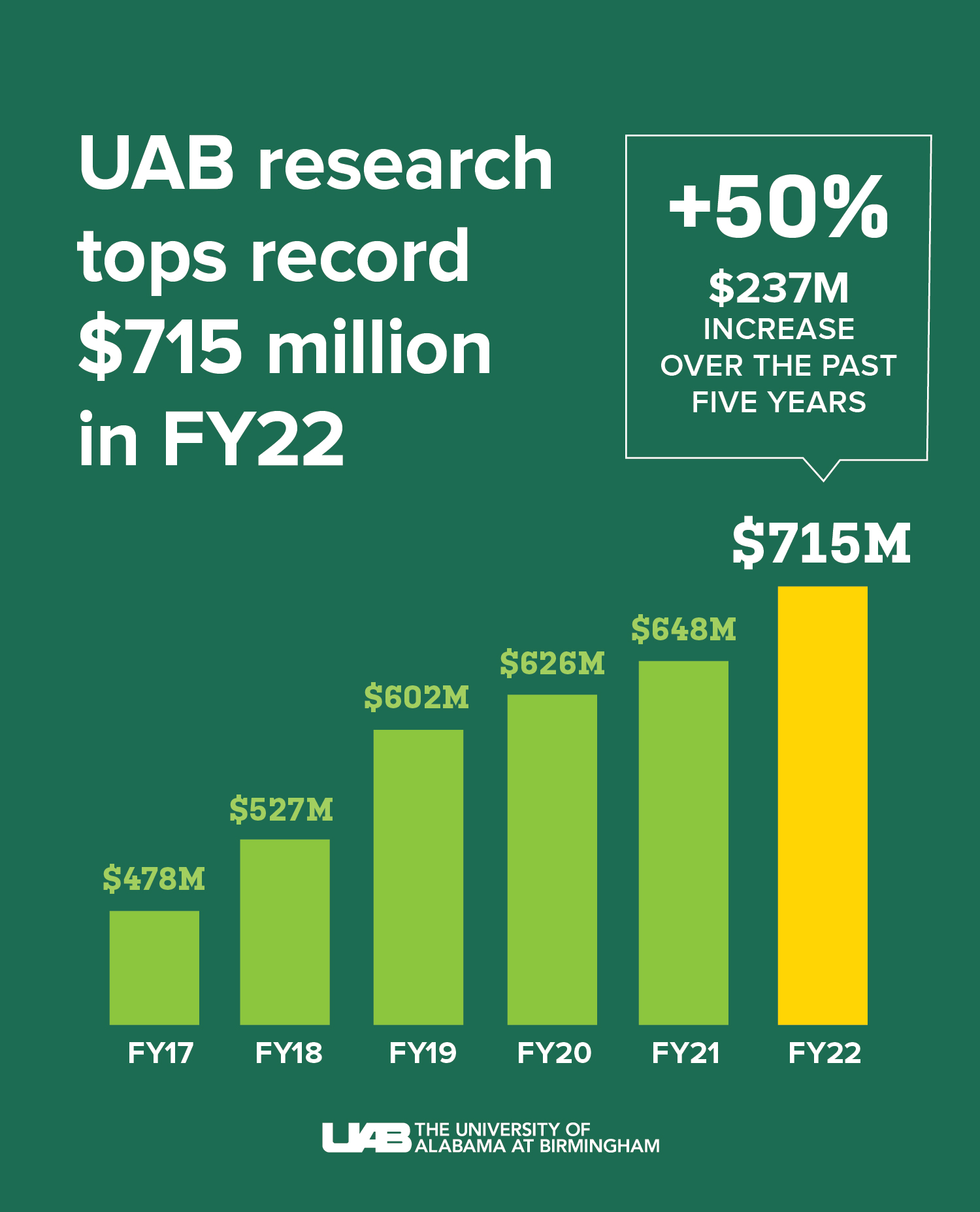Media contact: Alicia Rohan
 Graphic: Jody PotterThe University of Alabama at Birmingham has reached two institutional milestones and extended the most successful era of extramural research funding in the university’s history.
Graphic: Jody PotterThe University of Alabama at Birmingham has reached two institutional milestones and extended the most successful era of extramural research funding in the university’s history.
UAB received more than $715 million in research grants and extramural awards for the 12-month period ending Sept. 30, 2022, up $67.8 million from the previous year, according to data from its Office of Sponsored Programs. That figure represents a 10.5 percent increase for the year and a nearly 50 percent increase — an additional $237 million — during the past five years.
UAB President Ray L. Watts announced the results from the 2021-22 funding cycle today at his annual State of the University address. The event begins at 10:30 a.m. and can be viewed online here.
Christopher Brown, Ph.D., vice president for Research, credits UAB faculty, staff and students, as well as donors, partners and other supporters.
“The continued upward trajectory for funding reflects the caliber and commitment of our people who conduct, support, administer and market the research accomplished here,” Brown said. “We are grateful that the great ideas and drive to succeed are matched by university leadership, which has expanded the investment and infrastructure that enable us to excel in our mission.”
The commitment to expanding research, development and innovation that improves society is a key objective of UAB’s strategic plan, Forging the Future. To achieve that, UAB has sought to promote collaboration, diversify research, drive innovation, and facilitate the processes and products that increase the body of knowledge. These numbers help tell the story, Watts says.
“And while the numbers help tell the story, it’s not just about the money; it’s about the empowerment and the impact this research will bring to our community, our state and beyond,” Watts said. “When we set a goal, the goal is not just to have more research dollars, but to have more research accomplishments and achievements that we know will positively impact the lives of many people.
“UAB strives to innovate across all disciplines, and that continues to raise our ceiling for success in a very competitive environment. I am proud of our faculty, staff and students who make this research enterprise among the most competitive in the nation and around the globe.”
For FY 2022, UAB ranks among the top 5 percent of U.S. universities based on all federal research and development expenditures and in the top 1 percent of all public, private and international organizations funded by the National Institutes of Health.
Funding increase driven by three factors
Brown says several items contribute to the increasing bottom line, including continued growth in NIH funding, steady increases in clinical trial expenditures, and the hard work of the faculty, technical staff and administrative personnel to support it all.
Some of that may result from an increasingly diversified portfolio. For example, UAB’s $388 million funding from the National Institutes of Health is substantial, and this year represents 54 percent of overall awards while just 4 years ago represented 60 percent. This is due to growth in other funding sectors since that time.
“UAB is experiencing growth in other sectors, and that is what we want,” Brown said. Since 2018, awards from nonprofits and foundations have increased 48 percent to $53.5 million, National Science Foundation funding has increased 29 percent to $11.5 million, and support from the CDC has increased by 152 percent and is now over $20 million.
“It’s important that we increase these key elements of our portfolio while growing the total UAB research portfolio,” Brown said.
Other growth areas include industry and clinical trials, Brown says. Total industry awards, which include grants, funded trials and services, more than doubled (106 percent) since 2018 to exceed $150 million in 2022. Specifically, overall clinical trial expenditures exceeded $105 million for the first time.
An important part of our research is translating discoveries and advancements into real-world applications, Brown says. “At UAB, the Bill L. Harbert Institute for Innovation and Entrepreneurship helps translate research into an economic benefit by shepherding patents, licensing, spin-offs and startups that, in turn, benefit our research enterprise because those services attract and benefit faculty.”
In FY 2022, intellectual property disclosures managed by HIIE reached 106, plus eight patents were issued, 39 licenses were executed, four startups were launched, and $5.6 million in revenue was generated.
“Research at this level is an investment in our overall mission,” Brown said of the pursuit of growth and success in this arena. “We work to create and deploy new knowledge, as we educate and train the next generation of researchers.”